Under the background of continuous tightening environmental protection policies, the development of photovoltaic glass oxygen furnaces in China has gradually risen, from the previous 250 t/d to the current 650 t/d, 750 t/d, and 800 t/d. The Oxygen combustion glass furnaces have gradually become large-scale and industrialized, and scientific matching of glass furnace refractory types has become a top priority. Based on the physical and chemical properties and working principles of various refractory materials used in today‘s large-scale all-oxygen photovoltaic glass furnaces, combined with the alteration of various refractory materials in the hot state of glass furnaces, improvements are proposed to the refractory adaptation scheme for various parts of the glass furnace from an economic perspective.
1. Principles for selecting refractory materials for glass furnace
When selecting refractory materials for glass furnaces, the use requirements must be met, the economy of the glass furnace must be ensured, and the production and manufacturing must be convenient.
Before selecting refractory materials, the following factors need to be understood:
① The service life of the glass furnace;
② The requirements for glass quality;
③ Production capacity, i.e., melting rate and melting temperature;
④ Insulation conditions;
⑤ Economic efficiency.
Refractory materials for glass furnaces should meet the following requirements:
① Have a high softening and melting temperature, and the general refractoriness should not be less than 1580℃;
② Sufficient mechanical strength to resist impact, friction, high-temperature and high-speed flames, smog and dust erosion and other mechanical effects;
③ Good high-temperature structural strength, able to withstand mechanical loads for a long time at operating temperature;
④ Strong resistance to corrosion of various components of molten batch materials, molten glass and gaseous substances;
⑤ Little pollution to glass;
⑥ Good resistance to rapid cooling and heating (thermal shock);
⑦ Good high-temperature volume stability, small residual shrinkage or expansion;
⑧ Thermal properties such as heat capacity, thermal expansion, and thermal conductivity meet the use requirements;
⑨ Regular appearance and accurate size.
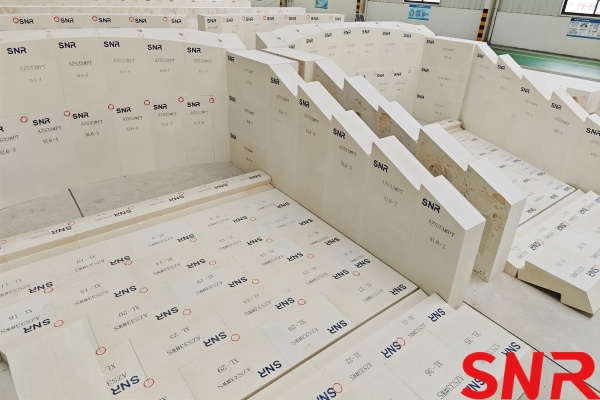
2. Performance and working principle of common refractory materials used in glass furnaces
2.1 Silica brick
Silica bricks are acidic refractory materials. Silica bricks for glass furnaces are siliceous refractory products mainly made of phosphotquartz and used for building high-temperature parts of glass furnaces. Their load deformation temperature is relatively high, with a fluctuation range of 1640-1680°C, which is close to the melting points of phosphotquartz and cristobalite (1670°C, 1713°C). High-quality silica bricks have the characteristics of high purity and density, high refractoriness under load, low reburning change, good high temperature creep resistance, high compressive strength at room temperature, reasonable mineral phase composition, low true density, and precise size. As the current photovoltaic glass furnaces are becoming larger and larger, the glass melting temperature is also high. Silica bricks are limited by low refractoriness (1690 ~ 1730°C) and poor thermal shock stability (heat exchange in water is 1 to 4 times), and cannot meet the requirements of the large crown of the melting tank, but it has become the only choice for the upper structure of the cooling tank. Its physical and chemical analysis is shown in Table 1.
Table 1. Physical and Chemical Indicators of Premium Silica Bricks for Glass Furnaces
|
|
Specifications |
||
|
XBG-96 |
ZBG-96 |
DBG-96 |
|
|
Unit weight/kg |
≤15 |
15~25 |
25~40 |
|
SiO₂/% |
≥96 |
≥96 |
≥96 |
|
Fe₂O₃/% |
≤0.9 |
≤0.9 |
≤1.0 |
|
Melting index/% |
≤0.5 |
≤0.5 |
≤0.6 |
|
Initial deformation temperature under 0.2MPa load/℃ |
≥1680 |
≥1680 |
≥1670 |
|
Apparent porosity/% |
≤22 |
≤23 |
≤24 |
|
Cold crushing strength/MPa |
≥35 |
≥30 |
≥30 |
|
True density/g·cm⁻³ |
≤2.34 |
≤2.34 |
≤2.35 |
|
Permanent linear change (1450℃, 2h)/% |
≤0.3 |
≤0.3 |
≤0.3 |
Note: Melt index is the sum of the mass fraction of alumina and twice the mass fraction of total basic oxides, that is, the mass fraction of Al2O3 + the mass fraction of 2R2O.
2.2 Clay bricks
Clay bricks are acidic refractory materials. As the Al2O3 content in the bricks increases, its acidity gradually weakens. Its thermal conductivity is the lowest among all refractory materials. Although its refractoriness is as high as 1700℃, its load softening temperature is only about 1300℃. When it is corroded by a large amount of R2O, the softening temperature will further drop to about 1050℃. Therefore, it cannot bear weight or pressure when used at high temperatures. The thermal expansion rate of clay bricks is the smallest among commonly used refractory materials. At the same time, due to the fine crystals and small and evenly distributed pores of clay bricks, stress is easier to buffer, so it has strong resistance to thermal shock in a wide range and can be used in the secondary important parts of the glass furnace, such as the selection of flue channel materials.
2.3 High Alumina Bricks
Alumina silicate refractory materials with Al2O3 content greater than 48% are collectively referred to as high alumina refractory materials. They are divided into 3 grades according to the Al2O3 content:
Grade I: Al2O3 ≥75%;
Grade II: Al2O3 60%~75%;
Grade III: Al2O3 48%~60%.
In the range of Al2O3 content less than 71.8%, with the increase of Al2O3 content, the main crystal phase mullite in high-alumina products increases; in the range of Al2O3 bigger than 71.8%, with the increase of Al2O3 content, the amount of mullite decreases and the amount of corundum increases. The refractory performance of the high alumina product increases with the increase of Al2O3 content. Compared with clay refractories, the outstanding advantages of high-alumina refractories are high refractoriness and load softening temperature. High-alumina refractory products have higher thermal conductivity than clay products. The thermal shock resistance of high-alumina refractory products is between clay products and siliceous products, and can be used for glass furnace big arch insulation layer retaining bricks.
2.4 Sillimanite Bricks
Compared with clay bricks, sillimanite bricks and mullite bricks have higher high-temperature load softening points, dense fine-grained structures, and are not easy to cause bubbles in glass liquid, which is very suitable for doghouse structure parts.
2.5 Mullite Bricks
The main crystal phase of mullite bricks is mullite. The refractoriness of mullite is about 1850℃, the load softening temperature is high, the high temperature creep rate is low, the thermal shock resistance is good, and the acid slag erosion resistance is good. It can be selected as the lower structure of the vertical flue and the inner surface of the horizontal flue.
2.6 Fused Mullite Brick
Fused mullite uses high-alumina bauxite as raw material, and different bauxites are mixed into the composition of mullite (3Al2O3·2SiO2), with a mass percentage of: Al2O3 72%, SiO2 28%. The main crystal phases are mullite and corundum, and the glass phase is filled between the crystal phases. Its resistance to glass liquid erosion is stronger than that of sintered refractory materials, but not as good as fused cast AZS refractory materials. Adding a small amount (7%~8.5%) of ZrO2 can make the mullite crystals smaller and the brick structure dense, and the mullite increases to 60%~70%, which relatively reduces the content of the glass phase and reduces the cracks of the product. Fused mullite bricks have low thermal expansion coefficient, good thermal shock resistance, and strong resistance to glass liquid erosion.
2.7 Fused Cast AZS Blocks
Fused Zirconia Corundum Bricks belong to the Al2O3-ZrO2-SiO2 system (fused cast AZS blocks for short). According to the ZrO2 content, they can be divided into three grades: 33%, 36%, and 41%. The volume percentage of their phase composition is shown in Table 2.
Table 2. Volume percentage of fused cast AZS blocks phase composition
|
Item |
33#AZS |
36#AZS |
41#AZS |
|
Corundum (including baddeleyite) |
76 |
77 |
73 |
|
Single baddeleyite |
6 |
9 |
14 |
|
Glass phase |
18 |
14 |
13 |
Compared with fused mullite bricks, fused cast AZS blocks have better resistance to glass liquid corrosion. The main reasons are:
① The main crystal phases in fused cast AZS blocks are corundum and baddeleyite coexisting in a dense manner. Both crystal phases have good corrosion resistance.
② The glass phase in fused cast AZS blocks fills the gap between the above crystal phases. After being corroded by high-temperature glass liquid, this glass phase generates a sodium feldspar glass with high viscosity. Since a certain amount of ZrO2 is melted in it, the viscosity is higher. This layer of high-viscosity glass remains on the surface of the block and is not easy to diffuse, protecting the block body. The corrosion resistance of fused cast AZS blocks increases with the increase of ZrO2 content. Among them, the melting temperature of ZrO2 is as high as about 2700℃, and it has high resistance to acid, alkali and glass liquid.
Fused cast AZS blocks are not only used in areas of contact with molten glass where the temperature is high and the corrosion is severe, but are also widely used in the upper structure of glass melting furnaces.
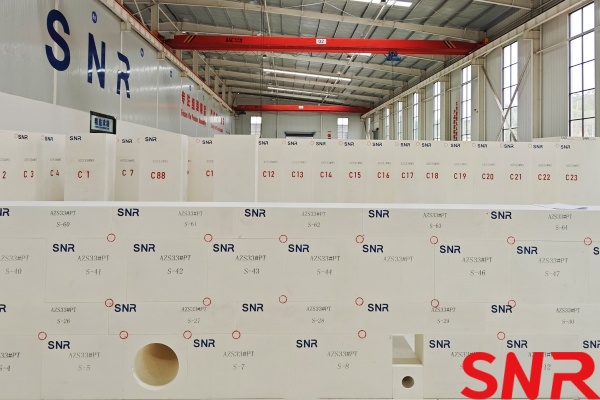
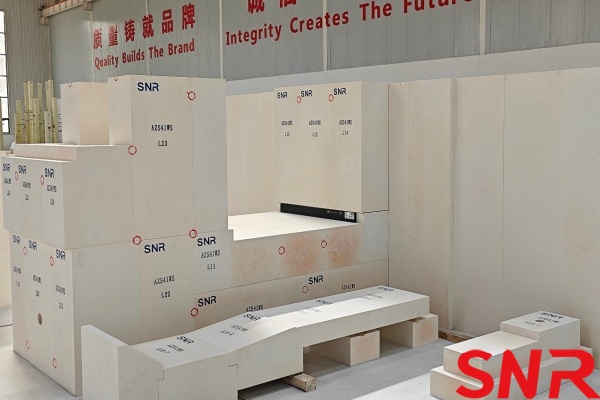
2.8 Fused corundum blocks
Fused corundum blocks α-β-Al2O3 (94.5%~96.5%) are made of high-purity alumina as raw material, with a small amount of soda ash introduced, and melted at 2000~2200℃. The crystal structure is composed of 45%~55% α- Al2O3 and 45%~60% β- Al2O3 phases. Since a large amount of β- Al2O3 is interwoven between α- Al2O3 crystals, the original α- Al2O3 tubular microstructure becomes a flaky structure, and the crystals are much smaller than when they exist alone. Therefore, its corrosion resistance is second only to α- Al2O3, while the heat deformation resistance of the block body is greatly improved. Therefore, it has become the best choice for the refractory material of the channel side wall and the melting part clarification area. The performance comparison analysis of fused cast AZS blocks and fused corundum blocks is shown in Table 3.
Table 3. Performance comparison of fused zirconium corundum and fused corundum bricks
|
Item |
Fused cast AZS block |
fused corundum blocks |
|||
|
AZS |
AZS36% |
AZS41% |
α-β-Al2O3 |
β-Al2O3 |
|
|
Resistance to glass erosion |
● |
○ |
☆ |
△ |
× |
|
Resistance to glass erosion |
○ |
○ |
○ |
☆ |
× |
|
Resistance to Na2O vapor |
☆ |
☆ |
☆ |
☆ |
☆ |
|
Resistance to batch dust |
○ |
○ |
○ |
● |
× |
|
Pollution resistance |
○ |
● |
○ |
☆ |
☆ |
|
Thermal stability |
● |
● |
△ |
× |
☆ |
|
Resistance to temperature fluctuations |
☆ |
☆ |
☆ |
× |
△ |
|
Application area |
Superstructure and bottom paving and others |
Superstructure and bottom paving and others |
The most seriously eroded parts such as throat and port neck |
The working end and the parts of the channel in contact with the glass melt |
Superstructure, nozzle block |
Note: ☆—best, ○—second best, ●—average, △—poor, ×—bad.
As can be seen from Table 3, the erosion of refractory materials at high temperatures is: AZS-41#>AZS-36#>AZS-33#>α-β-Al2O3, this is because the main crystal phases in the fused cast AZS blocks are the densely coexisting corundum (α-Al2O3) and baddeleyite (ZrO2), and both crystal phases have good corrosion resistance. The corrosion resistance of fused cast AZS block increases with the increase of ZrO2 content. Due to the high strength requirements of the skewback blocks, and considering that the volatiles of the molten glass are easy to gather here, the skewback blocks of the glass melting furnace should be selected as 33# fused cast AZS blocks. Similarly, the corners of the sidewall are more affected by the erosion of the molten glass, and the volatiles of the molten glass and alkali vapor are more likely to gather here. Generally, fused cast AZS blocks with a higher ZrO2 content should be selected, and 41# fused cast AZS blocks are the best.
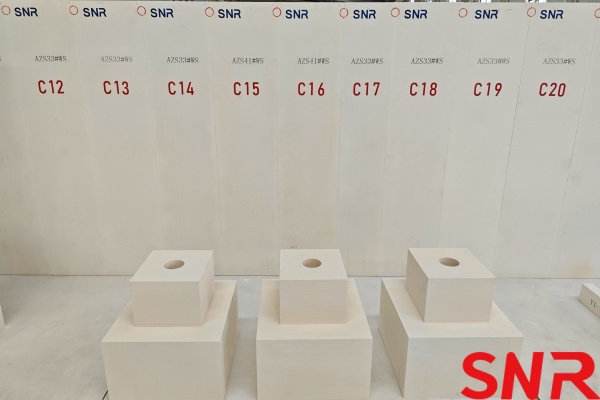
2.9 Zirconium-containing refractory bricks
Zirconium-containing refractory products are refractory products made of zirconium oxide (ZrO2) and zircon (ZrSiO4) as raw materials. Zirconium oxide series products, zircon series products, zircon mullite and zirconium corundum series products all belong to this type of products. According to different production processes, zirconium-containing refractory products are divided into bonded products, cast products and unfired products. Zirconium-containing refractory products have the characteristics of high melting point, low thermal conductivity, good chemical stability, especially good corrosion resistance to molten glass.
The properties of zirconium-containing refractory materials depend on the properties of ZrO2. The melting point of dense, stabilized zirconium oxide is 2677℃, and the operating temperature reaches 2500℃. The bulk density fluctuates between 4.5 and 5.5 g/cm3 due to the purity of the raw materials and the manufacturing method. The bulk density of dense zirconium oxide products can reach 5.75 g/cm3. Zirconia products have high mechanical strength, and the strength is maintained up to 1300-1500℃. The thermal conductivity of ZrO2 is much lower than that of all other oxide materials. This property of ZrO2 can be used to make high-temperature insulation layers.
3. Alteration of refractory materials in glass furnaces
The physical and chemical corrosion resistance of refractory materials is mainly determined by the type, distribution and bonding state of their constituent phases. Generally, refractory materials are composed of one or more crystal phases, glass phases and gas phases (pores). Glass is less chemically stable than crystals, and pores are channels (especially open pores) for corrosive agents to penetrate into the interior of refractory materials. The corrosive agents first act on the glass phase in the refractory materials, and react with each other. After the solution penetrates into the refractory materials and melts the glass phase, the crystals in the refractory materials will be corroded by the glass liquid, and new parts that continue to be corroded may continue to appear. Most of the pores and glass phases exist in the combination of bonded refractory materials, so the combination becomes the weak link in the resistance of refractory materials to physical and chemical corrosion.
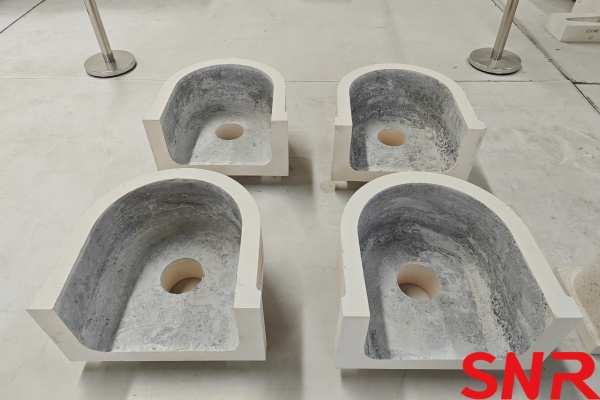
Nowadays, large glass furnaces mostly use bubbling clarification technology to increase the melting rate, but it also strengthens the convection of glass liquid, increases the temperature of deep glass liquid, and strengthens the erosion of refractory materials.
When adding batch materials to the glass furnace, the powder is easily carried away by the flowing gas in the glass furnace. The dust contains a lot of alkali, which often deposits on the upper surface of the sidewall blocks to form glaze and flow down along the surface of the blocks, forming deep grooves on the block surface, and even drips into the glass liquid, causing defects such as stripes on the glass liquid.
The upper structure of the glass furnace is often eroded by batch dust and volatiles. However, the dust reacts chemically with the refractory material, and its products mostly remain on the surface of the refractory material to form a thin film, which has a protective effect and can prevent the batch dust from further eroding the refractory material.
The volatiles of the batch material and glass liquid also chemically erode the refractory material. The volatiles are mainly alkali metal oxides and sulfides. These volatiles react chemically with the refractory materials in the gas phase, penetrate into the pores or gaps of the refractory materials, condense into liquid phase in the lower temperature parts, and react chemically with the refractory materials. The condensed liquid of these compounds corrodes the refractory materials more strongly, and penetrates deeply into the pores of the refractory materials through infiltration and diffusion, especially when there are cracks and gaps in the upper structure, which will cause great damage to the refractory materials.
In most cases, the batch dust and volatiles corrode the refractory materials together. The farther from the doghouse, the smaller the batch dust, while the upper structure of the working end and the feeding trough is only corroded by the volatiles of the glass liquid.
Both chemical corrosions can induce and promote mutual reactions between different refractories, reduce the strength of the refractory materials, and even cause physical damage.
4. Selection of refractory materials for various parts of the glass furnace
Refractory materials must be selected according to the different erosion conditions of various parts of the glass furnace. Combined with the alteration of refractory materials in the all-oxygen glass furnace and the properties of refractory materials of various materials, the selection of refractory materials should ensure two factors:
① Ensure the economy of the glass furnace. Starting from the actual situation, fully study the balance of the service life of refractory materials in various parts of the entire glass furnace, and achieve greater economic effects with smaller investments. Fully ensure the economy of the glass furnace and the balance of the entire glass furnace life.
② Convenient for production and manufacturing. When selecting refractory materials, both use and manufacturing should be taken into account. The standardization of refractory block types and sizes is conducive to the production of refractory materials, the finalization of glass furnace design, and construction and maintenance. The cost of standard blocks can usually save 30% to 50% compared with special-shaped blocks. Therefore, glass furnaces should give priority to the use of standardized refractory block types.
Combining the properties of various refractory materials and the principles of refractory alteration in glass furnaces, the refractory selection scheme for various parts of large-scale all-oxygen glass furnaces is shown below.
1. Crown/Arch
♦ Melting Tank Crown
Material: 33#Fused Cast AZS Brick (PT)
Temperature Range: 1400~1600°C
Selection Basis: Good erosion resistance, high mechanical strength, excellent thermal shock resistance, high refractoriness, and high load softening temperature.
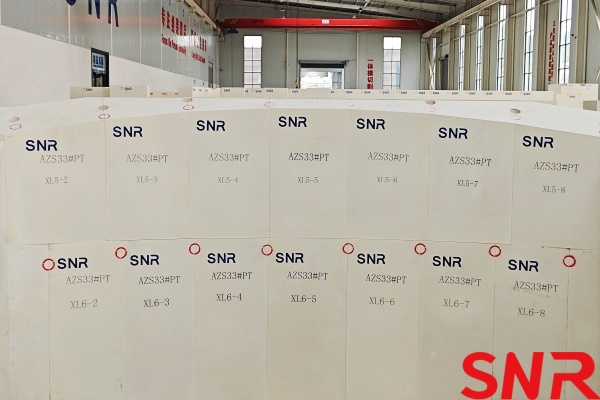
♦ Clarification Zone Crown:
Material: Fused α-β Corundum Block (PT)
Temperature Range: 1300~1500°C
Selection Basis: Excellent pollution resistance and erosion resistance.
2. Breast Wall
♦ Melting Tank Breast Wall
Material: 33#Fused Cast AZS Block (WS)
Temperature Range: 1530~1560°C
Selection Basis: Resistant to alkali erosion, strong resistance to atmosphere impact, good thermal shock resistance, and high refractoriness.
♦ Clarification Zone Breast Wall
Material: Fused α-β Corundum Block (WS)
Temperature Range: 1460~1560°C
Selection Basis: Excellent pollution resistance and erosion resistance.
♦ Tuck Stone Block
Material: 33#Fused Cast AZS Block (WS)
Temperature Range: 1450~1500°C
Selection Basis: High mechanical strength, erosion resistance, good thermal shock resistance, and high load softening temperature.
3. Side Wall (Tank Wall)
♦ Clarification Zone Side Wall and Back Gable Side Wall
Material: 33#Fused Cast AZS Block (VF)
Temperature Range: 1430~1470°C
Selection Basis: Good erosion resistance, high mechanical strength, excellent thermal shock resistance, high refractoriness, and high load softening temperature.
♦ Melting Tank Side Wall, Corner Side Wall, and Joint Filling
Material: 41#Fused Cast AZS Block (VF)
Temperature Range: 1450~1550°C
Selection Basis: Extremely high mechanical strength, erosion resistance, load softening temperature, and thermal shock resistance.
4. Back Gable Wall
♦ Gable Arch and First Layer Gable Block
Material: 33#Fused Cast AZS Block (WS)
Temperature Range: 1350~1450°C
Selection Basis: High mechanical strength, high load softening temperature, good erosion resistance, and thermal stability.
♦ Other Parts
Material: Fused α-β Corundum Block (WS)
Temperature Range: 1300~1400°C
Selection Basis: Relatively high load softening temperature, excellent pollution resistance, and erosion resistance.
5. Front Wall
Material: 33#Fused Cast AZS Block (WS), partially zircon brick in some areas
Temperature Range: 1430~1500°C
Selection Basis: High mechanical strength, good thermal shock stability, and strong corrosion resistance.
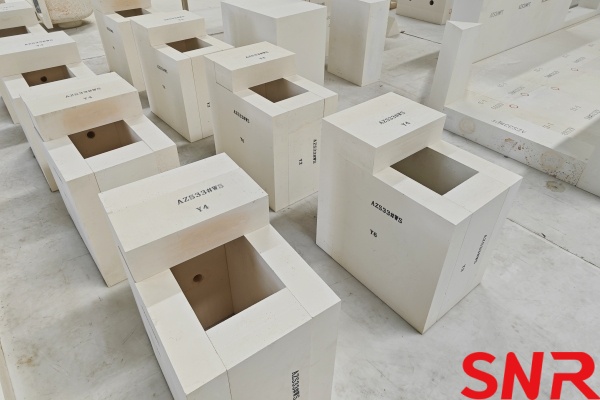
6. L-Type Hanging Wall (Doghouse)
Material: Bonded AZS Block
Temperature Range: 1350~1400°C
Selection Basis: Good alkali erosion resistance, relatively high mechanical strength, and cost-effective.
7. Tank Bottom
Large Blocks: Made of clay-based materials
First Layer Bricks: Bonded AZS Block is selected
Second Layer Bricks: 36#Fused Cast AZS Block (WS) is selected
Step Blocks: 41#Fused Cast AZS Block (WS) is selected
Temperature Range: 1000~1300°C.
8. Throat Area
♦ Throat Arch, Breast Wall, Tuck Stone Block
Material: Fused Mullite (Surface-Bonded) Brick
Temperature Range: 1300~1400°C
Selection Basis: Low thermal expansion coefficient, excellent thermal shock resistance, and strong resistance to glass melt erosion.
♦ Throat Tank Wall Bricks
Material: 41#Fused Cast AZS Block (VF)
Temperature Range: 1300~1360°C
Selection Basis: Excellent resistance to glass melt erosion, very high mechanical strength, and superior thermal shock stability.
♦ Throat Tank Bottom & Joint Filling
Materials: Clay Brick & 41#Fused Cast AZS Block (WS)
Temperature Range: 1000~1250°C
Selection Basis: High mechanical strength, good thermal shock stability, and strong resistance to glass melt erosion (referring to fused alumina-corundum).
9. Expansion Zone
♦ Crown, Breast Wall
Material: High-Quality Silica Brick
Temperature Range: 1250~1300°C
Selection Basis: Good pollution resistance, high mechanical strength, and resistance to glass melt erosion.
♦ Tank Wall, Tank Bottom & Joint Filling
Material: Fused α-β Corundum Block (WS)
Temperature Range: 1000~1200°C
Selection Basis: Excellent pollution resistance and erosion resistance.
10. Vertical Flue
♦ Upper Structure
Inner Wall: 33#Fused Cast AZS Block
Outer Wall: Mullite Brick (Insulation: Lightweight Mullite)
Temperature Range: 1100~1250°C
♦ Lower Structure:
Material: Mullite Brick
Temperature Range: 800~900°C
11. Horizontal Flue Channel
♦ Branch Flue Channel (Indoor):
Working Surface: Mullite Brick
Insulation: Lightweight High-Alumina Brick
Temperature Range: 600~700°C
Selection Basis: Low-temperature application, cost-effective.
♦ Main Flue Channel:
Working Surface: Clay Brick
Insulation: Lightweight Clay Brick
Temperature Range: 500~650°C
12. Burner Block
Material: Magnesia-Mullite Brick
Temperature Range: 1400~1600°C
Selection Basis: High mechanical strength, excellent wear resistance, and superior resistance to thermal/chemical impacts.
Note: PT refers to Regular casting, and WS refers to Void-free casting (both currently use oxide-based refractories).
5. Conclusion
In the glass industry, the quality of refractory materials is of great significance for improving the quality of glass products, saving fuel, extending the lifespan of glass melting furnaces, and reducing glass production costs. Refractory materials serve as the physical foundation of glass furnaces. Based on the varying working conditions of different glass furnace sections, combined with cost control, corrosion mechanisms, and properties of various refractory materials, the rational selection of refractories is key to ensuring stable and high production output in glass furnaces while reducing production costs.
Henan SNR Refractory Co., Ltd. is dedicated to the manufacture, research and development of fused cast AZS refractory materials and bonded refractory materials for the glass industry. Meanwhile, SNR can provide total solutions and services for glass furnace design, glass furnace construction, renovation, and upgrading. Please contact me if you have any requirements.
CONTACT: zoe@snrefractory.com/WhatsApp:+86 18172389584



